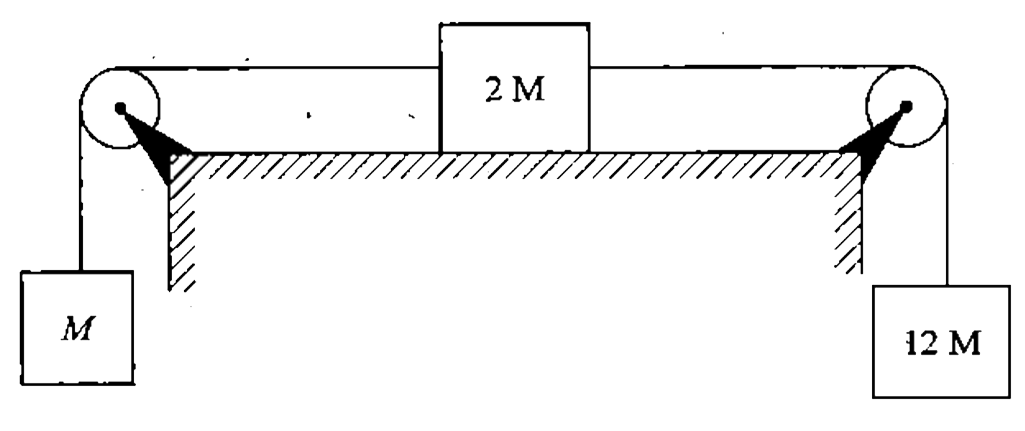A 550 kg rocket sled can be accelerated at a constant rate from rest to 1650 km/h in 2.0 s. What is the magnitude of the required net force ?
To solve the problem of finding the magnitude of the required net force for the rocket sled, we will follow these steps:
Step 1: Convert the final velocity from km/h to m/s
The final velocity given is 1650 km/h. To convert this to meters per second (m/s), we use the conversion factor:
1 km/h = (1000 m) / (3600 s)
So, we calculate:
1650km/h=1650×10003600m/s
=1650×518m/s
=458.33m/s
Step 2: Calculate the acceleration
The sled starts from rest (initial velocity u=0) and reaches a final velocity v=458.33m/s in t=2.0s. We can use the formula for acceleration a:
a=v−ut
Substituting the values:
a=458.33−02=458.332=229.165m/s2
Step 3: Calculate the net force using Newton's second law
According to Newton's second law, the net force F is given by:
F=m×a
Where m=550kg (mass of the rocket sled) and a=229.165m/s2 (acceleration calculated in the previous step). Thus:
F=550×229.165
F=125030.75N
Step 4: Round to appropriate significant figures
Since the mass is given to three significant figures, we round our force to three significant figures:
F≈1.25×105N
Final Answer
The magnitude of the required net force is approximately:
F≈1.25×105N
---
The final velocity given is 1650 km/h. To convert this to meters per second (m/s), we use the conversion factor:
1 km/h = (1000 m) / (3600 s)
1650km/h=1650×10003600m/s
=1650×518m/s
=458.33m/s
The sled starts from rest (initial velocity u=0) and reaches a final velocity v=458.33m/s in t=2.0s. We can use the formula for acceleration a:
a=v−ut
Substituting the values:
a=458.33−02=458.332=229.165m/s2
According to Newton's second law, the net force F is given by:
F=m×a
Where m=550kg (mass of the rocket sled) and a=229.165m/s2 (acceleration calculated in the previous step). Thus:
F=550×229.165
F=125030.75N
Since the mass is given to three significant figures, we round our force to three significant figures:
F≈1.25×105N
The magnitude of the required net force is approximately:
F≈1.25×105N
Topper's Solved these Questions
- FORCE AND MOTION - I BOOK - RESNICK AND HALLIDAYCHAPTER - FORCE AND MOTION - I EXERCISE - PRACTICE QUESTIONS (Single Correct Choice Type)
36 Videos
- FORCE AND MOTION - I BOOK - RESNICK AND HALLIDAYCHAPTER - FORCE AND MOTION - I EXERCISE - PRACTICE QUESTIONS (More than One Correct Choice Type)
5 Videos
- FORCE AND MOTION - I BOOK - RESNICK AND HALLIDAYCHAPTER - FORCE AND MOTION - I EXERCISE - CHECKPOINT
5 Videos
- FLUIDSBOOK - RESNICK AND HALLIDAYCHAPTER - FLUIDSEXERCISE - PRACTICE QUESTIONS (Integer Type )
5 Videos
- FORCE AND MOTION-IIBOOK - RESNICK AND HALLIDAYCHAPTER - FORCE AND MOTION-IIEXERCISE - PRACTICE QUESTIONS (Integer Type)
1 Videos
Similar Questions
An athelete takes 2.0 s to reach his maximum speed of 18.0 km/h. What is the magnitude of his average acceleration?
View SolutionThe three blocks in figure-2.25 are released from rest and accelerate at the rate of 5m/s2. If M = 4kg, what is the magnitude of the frictional force on the block that slides horizontally?

[140 N]
View Solution
Knowledge Check
A 810 kg car accelerates from rest to 27 m/s in a distance of 120 m. What is the magnitude of the average net force acting on the car ?
A740 NB2500 NC91 ND1300 NA 5kg. mass is accelerated from rest to 60 m/s in 1 sec. what force acts on it:-
A5×60NB(5/60)×981NC602×52ND(52)×602×981NA samll object of mass 10.0 g is at rest 30.0 cm from a horizontal disk's centre. The disk starts to rotate from rest about its centre with a constant angular acceleration of 4.50 rad/s2. What is the magnitude of the net force acting on the object after a time of t=13 s if the object remains at rest with respect to the disk ?
A0NB1.5×10−2NC7.4×10−3ND1.8×10−2N
An electron, starting from rest and moving with a constant acceleration, travels 2.00 cm in 5.00 ms. What is the magnitude of this acceleration ?
View SolutionA cylclist is riding with a speed of 27kmh−1. As he approaches a circular turn on the road of radius 80m, he applies brakes and reduces his speed at the constant rate of 0.5ms−2. What is the magnitude and direction of the net acceleration of the cyclist on the circular turn ?
View SolutionA motorboat starting from rest on a lake acceleration line at a constant rate of 3.0m/s2 for 8.0s. How far does the boat travel during this time ?
View SolutionA car starts from rest and moves around a circular track of radius 32.0 m. Its speed increases at the constant rate of 0.600m/s2. (a) What is the magnitude of its net linear acceleration 15.0 s later? (b) What angle does this net acceleration vector make with the car's velocity at this time?
View SolutionA cyclist is riding with a speed of 27 kmh−1 . As he approaches a circular turn on the road of radius 80 m, he applies brakes and reduces his speed at the constant rate 0.5 ms−2. What is the magnitude and direction of the net acceleration of the cyclist on the circular turn ?
View Solution
